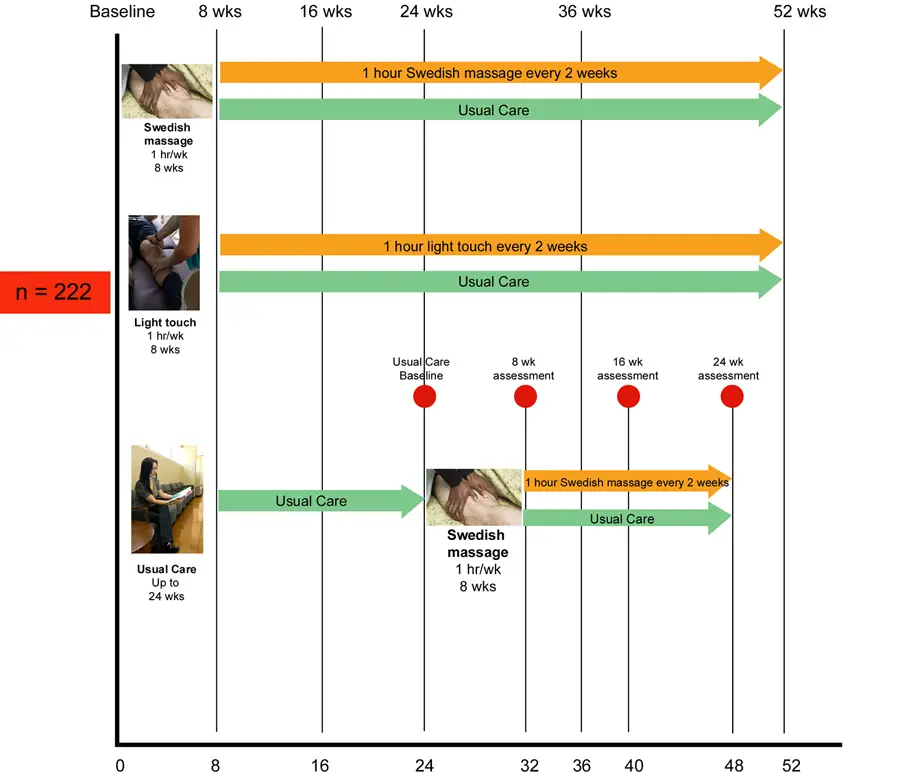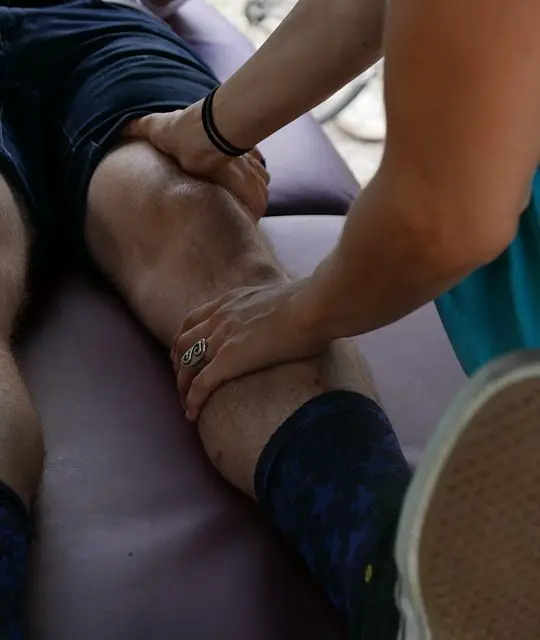A recent cross-sectional study from Duke Integrative Medicine in Durham, North Carolina, finds that massage therapy (Swedish) can alleviate pain among people with knee osteoarthritis, better than light touching or “usual care.” However, the benefits of massage therapy lessen after eight weeks, and by week 52, there was “no significant difference” among the groups.
Among 222 eligible subjects who enrolled in the study, they were randomized into three groups for the first eight weeks: massage therapy, light touch, and usual care. The massage group received one hour of full-body Swedish massage once a week, and the light touch group received touch (but no tissue “manipulation”) in a certain sequence, which involved the therapist placing hands upon a body part. After eight weeks, the subjects in these two groups were re-assessed for pain and range of motion and were reassigned to one of the following groups: 1 hour of “maintenance” Swedish massage or light touch (respective to the same group) every two weeks or usual care.
However, the usual care control group ended their care at 24 weeks, and the subjects received the same Swedish massage protocol for eight weeks. After that eight weeks, they were randomly assigned to either one hour of Swedish massage every two weeks or usual care for 16 weeks—up to week 48 of the entire study.
At the end of the study, the dropout rate was 8 (about 11%) for the massage group, 25 (about 34%) for the light touch group, and 7 (about 9%) for the usual care group. A large number of people dropped out from the light touch group because they reported that they don’t think there was much benefit from the treatment.

Image adapted from original study by Nick Ng.
“This study was [a] continuation of a line of research we have done investigating massage for osteoarthritis of the knee,” Dr. Adam Perlman explained to Massage & Fitness Magazine. “Massage is often used by people to treat painful conditions, arthritis being one of those. However, there was very little if any clinical research when we started to inform patients and healthcare providers regarding the safety and efficacy of massage. Contributing to that body of literature and enabling better, more evidence-based decisions that
hopefully leads to relief of suffering and improved quality of life for the multitude of people with chronic pain was the ultimate inspiration.
“They were reassigned to either maintenance massage, maintenance light touch (our ‘placebo’ intervention) or no maintenance in order to investigate if maintenance massage (every other week) would make a difference over the subsequent year.”
When I asked why the groups were divided a “maintenance” group and a “usual care” group, Perlman replied that getting a massage weekly for a year could be quite costly for most people in the real world. “We were hoping to show that you could cut back on the frequency,” he said. “Since we don’t know exactly what the subjects did outside of the study over that year, we can’t really say why all the groups improved, but the takeaway is that massage lead to more immediate improvement.”
“We attempted to track things like medication use and determine the cost-effectiveness of massage, but found that difficult,” Perlman added when I asked what could be improved in the study. “Not an improvement necessarily, but a different methodology would be to compare massage to other active interventions. We also need more investigation into the mechanism of massage for osteoarthritis and other conditions.”
Knee osteoarthritis options besides massage therapy
As aforementioned, massage therapy—even if it is biweekly—can be costly for many people with knee osteoarthritis or pretty much any similar conditions. Dr. Jeffrey Jackson from Zablocki VA Medical Center in Milwaukee, Wisconsin, emphasized, “What is not clear from this study is whether weekly Swedish massage might lead to sustained improvement. The improvement appears to last for the 8 weeks that weekly massage was being provided; after that, having a massage every other week appears to not be therapeutic.”
He cited a 2017 review of knee osteoarthritis treatment published by the Agency for Healthcare Research and Quality that found two non-pharmacological and non-invasive treatments that show some promising evidence of alleviating pain: weight loss and general exercise. (3)
“A common problem is that trials were either too short or too low quality to provide good evidence of efficacy. This study is a good example of the rigorous approach that needs to be incorporated to obtain strong evidence for benefit from CAM options,” Jackson wrote.
Limitations of knee osteoarthritis
Perlman et al. mentioned a few limitations that we should consider:
1. Small and somewhat homogeneous sample (mostly female and Caucasian)
2. Difficulty in blinding subjects and massage therapists to the active treatment groups. Thus, it is likely that the subjects’ bias may have influenced the high dropout rate and results of the light touch group. Bias among massage therapists may have also influenced the quality of the massage or light touch group.
3. The WOMAC scores among the subjects were not validated for clinical significance, which means we don’t really know for certainty if there is an noticeable difference among the groups.
4. The researchers did not assess for existing chronic diseases or psychological issues that are common among those with chronic pain, such as anxiety and depression.
Also, the data was gathered from one point in time, so we cannot establish a direct cause-and-effect relationship between massage or light touch with knee pain.
Even though massage therapy has short-term benefits, this does not mean that clients or patients in pain should not get a massage. For the majority, perhaps a better to way to treat knee osteoarthritic pain is a combination of exercise, massage, meds (when needed), and other lifestyle factors (e.g. sleep, diet, social support) that influence pain and function. Meanwhile Perlman et al. suggest that future research in massage therapy should compare the effects of massage therapy and light touch, such as biochemical, immunological, and mechanical.
“The message supported by our previous research and reinforced with this study is that massage is
a potentially effective short term strategy in addition to usual care for people with osteoarthritis
of the knee who are looking for a non-medication, non-surgical approach to improving their pain
and function,” Perlman said. “Our study didn’t investigate the efficacy of massage for other joints and the best
way to maintain the improvement long-term is still unclear.”
References
1. Perlman A, Fogerite SG. Efficacy and Safety of Massage for Osteoarthritis of the Knee: a Randomized Clinical Trial. J Gen Intern Med. 2018 Dec 12. doi: 10.1007/s11606-018-4763-5.
2. Jackson JL. Capsule Commentary on Perlman et al., Efficacy and Safety of Massage for Osteoarthritis of the Knee: a Randomized Clinical Trial. J Gen Intern Med. 2019 Jan 4. doi: 10.1007/s11606-018-4803-1.
3. Newberry SJ, FitzGerald J, SooHoo NF, Booth M, Marks J, Motala A, Apaydin E, Chen C, Raaen L, Shanman R, Shekelle PG. Treatment of Osteoarthritis of the Knee: An Update Review [Internet]. Rockville (MD): Agency for Healthcare Research and Quality (US); 2017 May Report No.: 17-EHC011-EF.
A native of San Diego for nearly 40 years, Nick Ng is an editor of Massage & Fitness Magazine, an online publication for manual therapists and the public who want to explore the science behind touch, pain, and exercise, and how to apply that in their hands-on practice or daily lives.
An alumni from San Diego State University with a B.A. in Graphic Communications, Nick also completed his massage therapy training at International Professional School of Bodywork in San Diego in 2014.
When he is not writing or reading, you would likely find him weightlifting at the gym, salsa dancing, or exploring new areas to walk and eat around Southern California.






